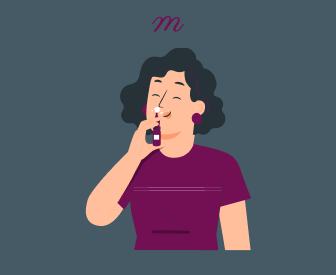Have your progress notes written for you automatically
Eating disorder is much more than a loss of appetite or an unwillingness to eat. It is an abnormal eating behavior that affects an individual’s physical and mental health. Eating disorders often involve extreme behaviors related to food, such as severe restriction, binge eating, or purging. They can affect individuals across all cultural backgrounds, genders, and age groups.
The Diagnostic and Statistical Manual of Mental Disorders, Fifth Edition (DSM-5), defines eating disorders which includes anorexia nervosa, bulimia nervosa, and binge-eating disorder. It provides the criteria mental health professionals use to diagnose these conditions, including specific signs and symptoms.
Prevalence of Eating Disorders
According to The National Eating Disorders Association, at least 28.8 million Americans will suffer from eating disorders at some point in their lives. The National Association of Anorexia Nervosa and Associated Disorders (ANAD) further explained that 15% of women suffer from these disorders in their 40s or 50s. About 95% of those who have eating disorders are between the ages of 12 and 25. Approximately 50% of people with eating disorders experience comorbid depression. However, only 27% of people receive treatment for the disorder.
The National Institute Of Mental Health (NIMH) supports ANAD’s findings. The NIMH’s research reveals that eating disorders are more prevalent in women than men. For example, the organization observed that binge eating was twice as high among females (1.6%) than males (0.8%). The American Psychological Association (APA), emphasized that certain traits increase the susceptibility of people to eating disorders. According to APA, individuals with perfectionism, anxiety, and low self-esteem are more susceptible to eating disorders.
Causes of Eating Disorders
Eating disorders are caused by several factors. These include stress, societal pressure, personal struggles and sometimes trauma. Eating disorders are shaped by many influences, not just personal choices. Cultural norms play a huge role too, and it often pressures individuals to meet specific body ideals. We frequently see thinness celebrated as the standard of beauty. Now, social media and advertising make this pressure even stronger. This leads to several people feeling that they must fit into these narrow expectations.
On top of that, biological factors like genetics and brain chemistry can make individuals more vulnerable to developing an eating disorder. These complex influences will help you understand that eating disorders are not just about food. They show deeper psychological, cultural, and biological challenges that deserve attention in treatment.
The DSM-5 has captured several eating disorders. They include:
Anorexia Nervosa
Anorexia Nervosa is an eating disorder which is characterized by severe food restriction. This is usually as a result of an intense fear of weight gain. This fear causes individuals with this disorder to significantly limit their food intake or engage in excessive exercise. Individuals with this disorder perceive themselves as overweight even when they are underweight.
According to the DSM-5, a diagnosis of Anorexia Nervosa is made when individuals exhibit the following symptoms:
- Restriction of food and energy intake relative to the expected requirements. This results in the clients having a lower weight than the expected range for their age, sex, developmental trajectory and physical health.
- Intense fear of weight gain or becoming fat leads to persistent weight-interfering behaviors. Significant low weight doesn’t hinder exhibiting these weight-altering behaviors.
- Distorted body image. Undue influence of body weight and shape on self-evaluation and perception. Accompanied with negligence of the gravity of current low body weight.
There are 2 major subtypes highlighted by DSM-5 in categorizing Anorexia Nervosa.
- Restricting Type
Individuals with this subtype have no recurring episodes of binge eating or purging behavior in three months.
- Binge-eating/Purging type
An individual will only be diagnosed with Anorexia Nervosa when they have engaged in recurrent episodes of binge eating or purging behavior in 3 months.
DSM-5 specified different criteria for determining the severity of Anorexia Nervosa.
Mild Anorexia Nervosa is when a client has a Body Mass Index that is greater than 17 kg/m2.
Moderate or severe Anorexia Nervosa is when the body mass falls within 16-16.99 kg/m2 and 15-15.99kg/m2 respectively.
Anorexia Nervosa is classified as “critical” when a client has a BMI < 15kg/m2.
There is partial remission when the full criteria has been met. In this case, a sustained period of low body weight is not met however, one of the following two criteria has to be met:
- Experiencing excessive fear of weight gain or obesity, along with behaviors that hinder weight increase.
OR
- Being highly disturbed by the weight and shape.
Then, there is the full remission where the full criteria has been met however, for a sustained period of time, none of the criteria is met anymore.
Bulimia Nervosa
Individuals suffering from Bulimia Nervosa tend to engage in a cycle of binge eating. This cycle of binge eating is successively followed by unhealthy compensatory actions to avoid weight gain. These individuals typically consume large amounts of food within a short time frame. This action is often followed by trying to get rid of the food from the body by purging, vomiting, or using laxatives. In some cases, individuals with Bulimia Nervosa may indulge in excessive fasting or exercising. The preoccupation with food and efforts to control weight gain produce feelings of guilt, shame, and disgust.
For an individual to be diagnosed with Bulimia Nervosa, they have to meet the following criteria:
Recurrent episodes of binge eating which includes:
1. Eating large amounts of food in a discrete period (e.g., within any 2-hour period). This food quantity is usually larger than what most individuals consume within that time in such a situation.
2. Inability to control eating rate during binge-eating episodes (the individuals feels incapable of controlling what or how much food is being eaten).
3. Frequent extreme measures taken to prevent weight gain after a binge-eating episode. This could include self-induced vomiting or reckless use of laxatives, diuretics, and other medications. The individual might also engage in fasting; or excessive exercise.
4. Binge eating followed by compensatory behaviors to control weight gain. It happens once a week over the course of three months.
5. The self-evaluation and self-perception are influenced by body shape and weight.
6. The disturbance does not occur exclusively when the individual is having episodes of anorexia nervosa.
The severity of Bulimia Nervosa is measured by the frequency of inappropriate compensatory behaviors. A mild and moderate situation is when a client has 1-3 or 4-7 inappropriate compensatory behaviors respectively in a week. When a client begins to have the episodes 8-13 times, it’s a severe case. An extreme case is seen in an individual who has these inappropriate compensatory behaviors with an average of episodes 14 or more times a week.
Binge-Eating Disorder
Binge-eating disorder is characterized by uncontrollable, compulsive eating until an individual is uncomfortably full. It is a mental health disorder seen in people who frequently eat large portions of food within short periods of time regularly. Binge eating disorder is the most common eating disorder in the US.
DSM-5 criteria for individuals with Binge-eating disorder includes:
- Recurrent episodes of binge eating. In this case, such individuals exhibits the following symptoms:
- Frequent instances of binge eating within any discrete or 2-hour period. During that time, the individual eats more food than other people will typically consume.
- Usually, the eating is characterized by a lack of control over the eating during the episode.
2. The binge eating episode is usually characterized by at least 3 of the following:
- More rapid food consumption than normal.
- The individual finds themselves eating until they are uncomfortably full.
- The individual tends to still eat a lot of food even though not hungry.
- Due to the embarrassment of the large amount of food being consumed, such an individual tends to eat alone.
- Over time, this leads to depression, guilt and disgust with oneself.
3. Lack of willingness to perform inappropriate compensatory actions after a binge eating episode.
4. There is notable distress present that comes with binge eating.
5. Binge eating happens at an average of once a week for 3 months.
6. Unlike Anorexia Nervosa and Bulimia Nervosa, the individual eats excessively without any recurrent compensatory attempts to lose or prevent weight gain. Binge eating does not occur exclusively while experiencing anorexia nervosa or bulimia nervosa.
Individuals are diagnosed with mild and moderate binge-eating disorder when they experience 1-3 or 4-7 binge-eating episodes respectively in a week. The individual is diagnosed with extreme binge eating disorder once the number of episodes rises to 8–13. It becomes extreme when the average binge eating occurs 14 times or more in a week.
Other Specified Feeding or Eating Disorders (OSFED)
Sometimes, people show signs of an eating disorder that don’t fit any one diagnosis exactly. These symptoms can still disrupt their lives—impacting their work, relationships, or daily activities. In these cases, clinicians use the term OSFED, which stands for “Other Specified Feeding and Eating Disorders.” This allows a mental health therapist to explain why the full criteria for a specific disorder aren’t met. They document “OSFED” and then state the reason, like “bulimia nervosa of low frequency.”
Even though OSFED doesn’t meet the full criteria for specific eating disorders, it still causes distress and abnormal eating patterns. This leads to significant impairment in critical areas of an individual’s functioning. The OSFED include:
Atypical Anorexia Nervosa
Atypical Anorexia Nervosa meets all the criteria for Anorexia Nervosa. The only difference is that individuals with Atypical Anorexia Nervosa have weights that are within or beyond the normal range. There is also significant weight loss.
Infrequent and/or Short-Term Bulimia Nervosa
In this case, the individual meets all the criteria for Bulimia Nervosa except in the binge eating and the inappropriate compensatory behaviors. These individuals often experience the disorder less than once a week on average or for fewer than three months.
Infrequent and/or Short-Term Binge-Eating Disorder
Individuals with this type of disorder have all the symptoms of binge-eating disorder. However, the binge-eating symptoms are less frequent than regular clients.
Purging Disorder
Individuals with purging disorder exhibit recurrent purging behavior. They do this to influence their weight and shape without binge eating. These behaviors can come in the form of abusing laxatives, medications, diuretics and self-induced vomiting.
Night Eating Syndrome
Night Eating Syndrome involves repeated episodes of eating after waking up or consuming too much food after dinner. The person is fully aware of and can remember these episodes. Night eating is not caused by outside factors, like changes in sleep patterns or cultural norms. Although this eating pattern leads to distress or disruption in daily life. It’s important to note that this behavior isn’t explained by binge-eating disorder, another mental illness, substance use, or a medical condition. It is also not caused by the side effects of medication.
PICA
Pica is one of the most dangerous eating disorders described by DSM 5. Individuals with this disorder persistently consume non-nutritive or non-food items at least once a month. These non-food items could range from clay or dirt, to hair, paper or metal. Pica is more common in children, but it sometimes occurs in adults as well.
Usually, clients are diagnosed with Pica when the following criteria:
- They engage in persistent consumption of non-nutritive, nonfood substances within one month or more.
- This consumption of non-food substances that are not nutritional is inconsistent with the developmental level of the individual. The eating behavior is inconsistent with culturally supported or socially acceptable practices.
- The behavior is co-occurring with other underlying mental disorders like the autism spectrum disorder or intellectual disability. If it is also occurring in the context of a medical condition like pregnancy, then it is deemed necessary to require medical attention.
Rumination Disorder
Rumination Disorder is an eating disorder characterized by the repeated regurgitation of recently ingested food.. Before diagnosing an individual with rumination disorder, mental health practitioners confirm the presence of the following symptoms:
- This regurgitation must have occurred over at least 1 month. After the regurgitation, the individual either re-chew, re-swallow it or spits it out.
- Repeated regurgitation of food that is not traceable to any underlying gastrointestinal or medical condition such as reflux.
- This disorder is not occurring exclusively while the individual experiences either binge eating disorder, bulimia nervosa, anorexia nervosa, or avoidant/restrictive food intake disorder.
- The condition is not occurring due to an underlying mental disorder like intellectual disability which is significant enough to require extra clinical attention.
Avoidant/Restrictive Food Intake Disorder (ARFID)
Avoidant/Restrictive Food Intake Disorder (ARFID) is characterized by severe avoidance of certain foods or limited consumption. This often leads to nutritional deficiencies and serious health challenges. People with ARFID may lose their eating appetite or have excessive fear about the consequences of certain foods. These fears include vomiting and chocking. Unlike anorexia or bulimia, ARFID is not driven by body image concerns. While it is more prevalent in children, adults can also experience it.
Before an individual is diagnosed with ARFID, they have to meet the following criteria:
- An eating disturbance marked by disinterest in food or complete avoidance of meals. It leads to a failure to get enough nutrition or energy, shown by one or more of these:
- Remarkable weight loss or not gaining enough weight, especially in kids.
- Serious nutritional deficiencies.
- Reliance on enteral tube feeding or needing nutritional supplements.
- Major problems with psychosocial functioning, affecting daily life.
2. The disruption in eating is not due to the food that is not available or typical cultural norms.
3. The eating problem does not happen only during bulimia nervosa or anorexia nervosa, and there is no issue with how body weight or shape is seen.
4. The issue with food consumption is not caused by a medical illness or a different mental condition. If it happens with another condition, its severity is greater than what’s normal and needs extra help.
Unspecified Feeding Or Eating Disorder
Unspecified Feeding or Eating Disorder (UFED) applies to individuals who present with symptoms of a feeding or eating disorder. These symptoms lead to significant distress or impairment in social, occupational or other vital areas of functioning. However, they do not meet all criteria for any specific disorder. The UFED category is utilized when the clinician decides not to specify why criteria are unmet. It also covers situations with insufficient information to provide a more precise diagnosis, like in emergency room settings.
Treatment Approaches
DSM 5 didn’t leave readers in the dark about techniques that can be used to solve eating disorders. Some of the listed approaches for solving eating disorders are:
Psychotherapy
Psychotherapy is essential for treating eating disorders. A widely used method is Cognitive Behavioral Therapy (CBT). It helps clients recognize and challenge negative thoughts about food. CBT incorporates cognitive restructuring enabling clients to shift their thinking and develop healthier eating patterns. In addition to CBT, therapists may use Dialectical Behavior Therapy (DBT) to help clients overcome these challenges.
Nutritional Counseling
Nutritional Counseling is one of the most important approaches to treating eating disorders. Dietitians work with clients to develop a balanced meal plan that meets their nutritional needs. They also help clients understand healthy eating habits and support them in overcoming these food-related challenges.
Medical Monitoring and Intervention
Due to the risks associated with eating disorders, clients might need to undergo medical monitoring. Healthcare providers check for vital signs like the heart rate, blood pressure, weight and temperature. They may also need to run blood tests to examine the electrolyte balance and overall health of the client.
Medications
Medications are often used to support the treatment of eating disorders. Anxiolytics and Antidepressants are commonly prescribed to help manage anxiety and depressive symptoms that frequently accompany these disorders. These medications can improve the therapeutic outcomes of treatment. Medications play a vital role facilitating a smoother recovery process and improving overall mental health of clients diagnosed with eating disorders.
Conclusion
Eating disorders significantly impact your client’s overall well-being and mental health. Comprehending these eating disorders is crucial for promoting recovery. By recognizing the signs and causes, individuals can also be empowered to seek help sooner.
In this guide, we explored the various eating disorders outlined in the DSM-5, focusing on their diagnostic criteria and treatment approaches. This knowledge is not just for mental health professionals; it’s vital for everyone. Awareness can foster compassion, understanding, and support for those affected.
Knowledge of the DSM-5 criteria empowers clinicians and healthcare practitioners to address these disorders effectively. By becoming better informed, we can turn this knowledge into action and create a path toward healing.
Frequently Asked Questions
What Are The Warning Signs Of Eating Disorders?
Warning signs of eating disorders include drastic weight changes and preoccupation with food and dieting. Excessive exercise is also common. Individuals may withdraw from social activities and experience significant mood swings. Additional indicators involve hidden eating behaviors and utilizing food as a way to cope.
How Can You Support People With Eating Disorders?
Supporting people with eating disorders demands empathy and understanding. As a health care provider or family member, you need to learn to listen without judgment and encourage open communication. It is best to promote the importance of seeking professional help and offer to assist in finding resources. Also, avoid commenting on their appearance or eating habits, as this can be triggering.
Are Eating Disorders Peculiar to Women?
Eating disorders are often diagnosed in women, but they can affect anyone. This issue is not gender-specific. Men and individuals across the gender spectrum can also experience eating disorders. Awareness is crucial to ensure that everyone receives the support they need.
What Are the Potential Risks of Untreated Eating Disorders?
Eating disorders can lead to chronic anxiety, and depression. Gastrointestinal issues may arise, along with electrolyte imbalances and organ failure. In extreme cases, untreated eating disorders can be life-threatening. Early intervention is essential to prevent these serious outcomes.
What Are the Three Things That Can Cause Eating Disorders?
The three main causes of eating disorders are psychological factors, sociocultural influences, and biological factors. Psychological factors include low self-esteem and negative body image. Sociocultural influences often stem from societal pressures and cultural norms regarding appearance. Biological factors may include genetics and imbalances in brain chemicals that contribute to eating disorders.
References
- National Eating Disorders Association. (n.d.). Statistics & research on eating disorders. Retrieved from https://www.nationaleatingdisorders.org/statistics-research-eating-disorders
- National Association of Anorexia Nervosa and Associated Disorders. (n.d.). Eating disorders statistics. Retrieved from https://anad.org/eating-disorder-statistic/
- National Institute of Mental Health. (2023). Eating disorders. Retrieved from https://www.nimh.nih.gov/health/statistics/eating-disorders
- American Psychological Association. (2019). Eating disorders. Retrieved from https://www.apa.org/topics/eating-disorders
Disclaimer
All examples of mental health documentation are fictional and for informational purposes only.










